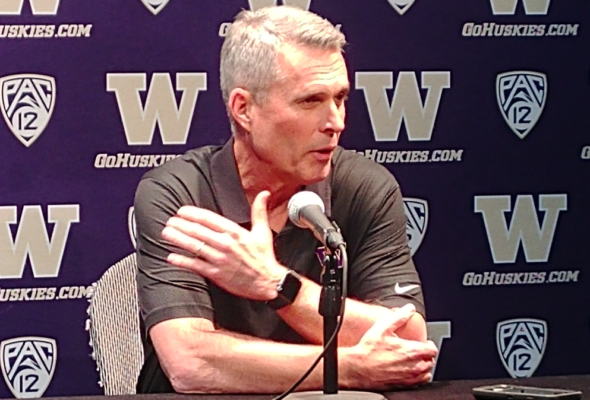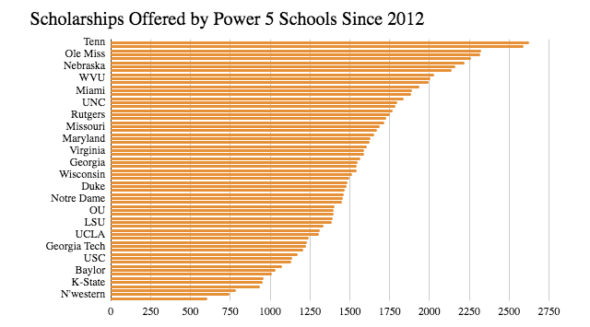
College football recruiting for most schools and fans is like ordering from a menu written in Chinese. Pictures are helpful, and previous experiences of random selections generally turned out all right, even if it was never clear what was being eaten.
For many recruits, however, the analogy is the chef from Seinfeld. For reasons often not clear, they are surprised with a harsh denial: “No soup for you!” More on this later.
Along with the rest of the national industry on letter of intent day Wednesday, the Washington Huskies rolled out a list of 22 newcomers in the class of 2019 (bios of signees here). While the various high school recruiting sites claim that the UW has another top-20 class, coach Chris Petersen shrugged.
“You don’t really know how it’s going to go with these kids,” he said. He was blowing smoke, but the faux candor was more credible than the recruiting hype machines that purport to understand the destinies of 17-year-old boys.
“I know nobody’s going to get up on signing day and say, ‘Yeah, we feel bad about this class,'” he said. There did seem to be genuine purple elation about a pair of defenders from California that were locked up in the final 24 hours: ILB Daniel Heimuli (6-0, 215) from Palo Alto and S Asa Turner (6-2, 199) from Carlsbad.
“We’re really, really excited (about them),” he said. “We’ve been recruiting those guys for a long time. To finally get them signed and coming here, it’s an exciting time. Those guys will make us better.
“Daniel was one of those guys that we really liked a ton as a junior. We thought he was one of the better players, with a really big upside. His senior year you could kind of see him each game just getting better.
“Asa’s a big, athletic, rangy guy that’s what we kind of like back there — he can come down and tackle in space. The secondary is certainly an area of need with the guys that we graduated. I feel really good about him.”
But enough about the schools and players who made football matrimony. Sports Illustrated has an intriguing story this week about the broken relationships: Recruiting’s Bait and Switch: The Uncommitable Scholarship Offer.
Analyzing the national database of the recruiting cabal’s largest operator, 247Sports, over the past eight recruiting cycles, SI discovered large annual increases in the number of uncommitted scholarships offered, and subsequently withdrawn. Over the period, among major conferences:
. . . more than 101,000 scholarship offers were issued in order to fill about 12,000 available scholarships. For the 2019 cycle alone, the 65 programs in Power 5 conferences made more than 15,000 scholarship offers in order to secure what is expected be about 1,600 signees. That’s an average of about 237 offers per school per year, a 100-offer increase from the average in 2012.
The intricate dance has been part of big-time college recruiting for decades: By NCAA rule, schools can unofficially offer and withdraw scholarships, and recruits can unofficially rescind their oral commitments to chase other offers. Nothing is official between the parties until days like Wednesday’s national LOI day.

The basic unfairness is that coaching staffs know how to bait and switch far better than recruits and their families know how to respond. The classic case is the recruit who commits early to the school of his dreams, only to be dumped late by the school, which gives the scholarship to what it thinks is a better player. The recruit loses out on the chance to find a better opportunity.
It’s a bad deal that’s getting worse, according to SI. Schools now are flinging offers like confetti.
Tennessee of the Southeastern Conference is the most profligate abuser. They had more than 440 offers out this year, and averaged 328 over the eight years that were examined, for classes that are rarely allowed to exceed 25 a year.
“It’s definitely something that’s gotten worse,” 247Sports scouting director Barton Simmons told SI. “This devalues the offer. Some programs fight to keep the value of their offer up. Other programs maybe don’t see the point of fighting it, and they play the game.”
At Washington, Petersen thinks he has taken a higher road — if such a thing exists in college sports. Asked how many offers UW had out for this class, he said didn’t know precisely Wednesday, but Thursday reported a figure of 90. (Note: In an earlier version of the column, Petersen estimated between 120 and 130).
“I think the last two or three years we’ve been in the bottom three schools in the Power 5 conferences in the least amount (of offers),” he said. “We kinda take pride in that. It keeps us focused.”
Still, that’s about 100 recruits UW sought and didn’t get. Whether the decisions were the choices of player or school is known only to the coaches, and a lot of UW’s misses landed with other top-tier programs. It’s the lower-rated recruits who are are more vulnerable.
Petersen sort of dodged a question of whether the current bait-and-switch system was unfair to the recruit.
“I wish the whole recruiting process would slow down,” he said. “But everything is going the opposite way, faster and faster. A lot of our coaches are looking at younger (recruits). Offers are coming out earlier than they ever have to younger guys. The whole thing keeps getting accelerated.
“I don’t think it’s better for the overall picture, for the kids and the whole process. A lot of coaches would agree with that. But it is what it is. You gotta play the game.”
The game, it seems, remains heavily in favor of the schools, most of whom, in the name of winning, seem oblivious to the cheapening of the product and mission, and are hardened to the loss of soup for recruits.
Anyone advocating change needs to be reminded that there are few American institutions more reform-resistant than the NCAA.

20 Comments
There’s always been something dirty and desperate about recruiting from colleges, so much so that high schools are entering the fray (see Bellevue, and if you think that’s the only public high school to do it…). Many of these kids will want and get an education – the majority. Some are using it as an unpaid minor league. Or not so unpaid, as we are now discovering in painfully small doses of actual journalism. I’d like to see more coverage of team collective GPAs and graduation rates (although these can be fudged), but we never will, I’m afraid. This is why the game has become such a regional sport. The SEC (except Vanderbilt) doesn’t care about such things and is rewarded for that feeling year after year.
Bellevue is a piker compared to Federal Way High School basketball.
Let’s not start, or we’ll be here all day.
Woodward and Bernstein considered FWHS boys basketball and backed off out of sheer volume.
The basic dishonesty has always been there, and will always be there as long as universities believe public entertainment is part of the mission statement. Every other country in the world directs superior athletes to academies where they can get at least a life-skills education built around the athletic-training schedule. Not us.
During the Don James era it seemed from afar the scholarship athletes were all herded into three majors; physical education, sociology, and criminal justice (police work). I remember in the late ’60s a sprinkling of football players in more rigorous majors. Steve Bramwell was in pre-med and I remember Bob Berg being in a civil engineering class with me.
Yes, there were soft majors for athletes, and it still exists, at UW and all schools. Stanford has a PE major that allows it to recruit and keep players who can’t meet the academic standards. Handfuls of players at both schools are disciplined enough to get rigorous degrees.
Recruiting has always been messy. Decades ago a player would show up at one school, and later at another with a different name. Years ago, recruiting was criticized because schools would stack recruits (especially at skill positions) in order for rival schools not to sign them. This was especially prevalent with black players. Recruiting was not extensively covered, and a player would show up on campus to find seven other running backs ahead of him. Transfer rules and protocol were different as well, so it was either remain in the depth chart or hit the road. It was very unfair and discriminatory.
You’re right, of course, and things have improved. But here it is 2019 and the process is still unfair to the recruit. They still remain under-compensated for the risks they take with their bodies and brains.
You don’t necessarily need to recruit 4-5 star athletes to have a successful program though it does help and brings notoriety to the school. The Huskies have had many a story over the years of walk-ons who later became starters or even All-Conference players.
Lots of schools mine walk-on talent. Regarding the absence of 4-5 star athletes, that’s the difference between the Huskies and the past 3 bowl opponents. UW is still a successful, less-abusive program, Huskies fans have a right to be proud.
Every time I might be inclined to be sympathetic to the cause of today’s college athletes – like, after reading this piece – I’m reminded why it took me more than 10 years to get my degree. Because I had to pay for it myself. All of it.
Are you lamenting your failure to be a good athlete, or seeking pity?
Bazinga!!!!!!!!!
Many countries think that their youth are the best investment money can buy, and price Education accordingly.
This country seems to believe it’s buying / owning those who make the laws that’s the best investment.
I guess it just depends on one’s committment to Country.
Art, with all due respect, Petersen and staff are better at this than 98% of FBS schools. Pretty ironic that he is featured in an article about schools giving out more offers than they can take. Also, can you point to one recruit that committed early to Petersen at UW who was later dropped? I would dare say I’ve followed UW recruiting closer than all but two Seattle journalists over the last 6 years (Jude and Caple – I’m not counting the recruiting site/fan site people though I know some have press credentials) and I can’t think of one instance. Throwing Petersen in here prominently I think is misleading.
I don’t seeing anything misleading. He’s the local guy who has avoided the worst aspects of the abuse, and his success merits a sharing of his views. But all schools are complicit in the bait-and-switch custom of the industry.
There’s no data on UW cases because neither side wants it known why the recruitment didn’t work. It’s anecdotal, not documentable, but coaches, parents and kids over the years have talked generally about the smarmy nature of the practice.
Mr. Art This one is off topic but who really cares?
Enjoy tonight’s event and bask in the appreciation by all the attendees. Take a second and reflect on a successful gig over the years. For later on, remember the respect, appreciation, and true admiration.
Later on, mentally put yourself in that group with Emmett “Watkins” Watson, Royal Brougham, Tim Egan, David Horsey, and of course, Steve Rudman and J (no period) Michael Kenyon. How’s that for a Seattle writing fraternity? Not bad even if I say so my little self.
Well done, sir.
I’m flattered with the company with which you have connected me. And yes, it was a fine evening for which I am humbled.
Well done yourself, Spumoni. Well done indeed.